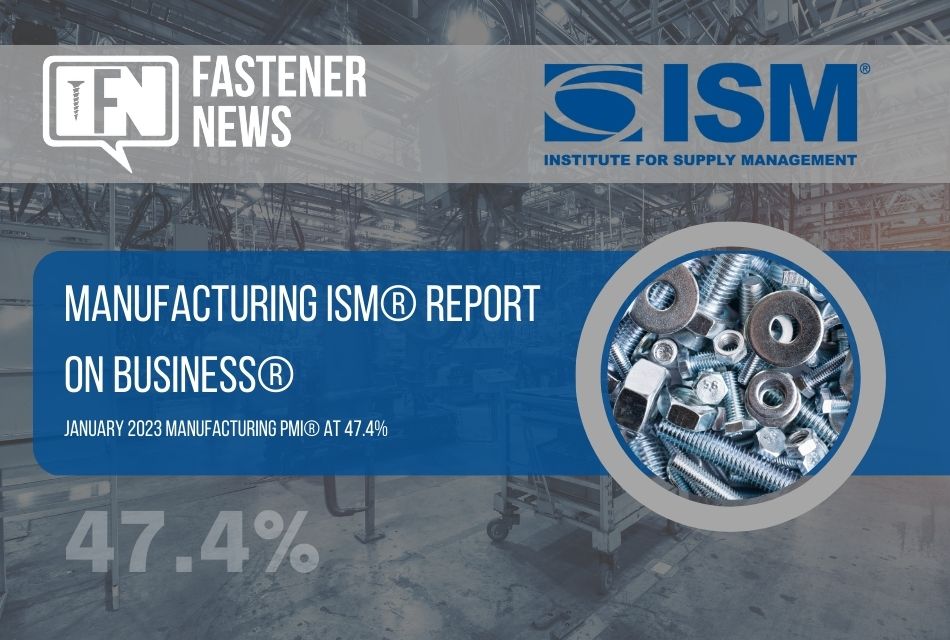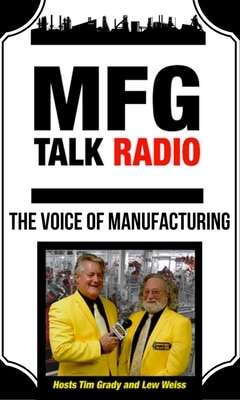
Feb 01, 2023
New Orders and Production Contracting; Backlogs Contracting; Supplier Deliveries Faster; Raw Materials Inventories Growing; Customers’ Inventories Too Low; Prices Decreasing; Exports and Imports Contracting
This report reflects the recently completed annual adjustments to the seasonal factors used to calculate the indexes.
TEMPE, Ariz., Feb. 1, 2023 /PRNewswire/ — Economic activity in the manufacturing sector contracted in January for the third consecutive month following a 28-month period of growth, say the nation’s supply executives in the latest Manufacturing ISM® Report On Business® .
The report was issued today by Timothy R. Fiore, CPSM, C.P.M., Chair of the Institute for Supply Management® (ISM®) Manufacturing Business Survey Committee:
“The January Manufacturing PMI® registered 47.4 percent, 1 percentage point lower than the seasonally adjusted 48.4 percent recorded in December. Regarding the overall economy, this figure indicates a second month of contraction after a 30-month period of expansion. The Manufacturing PMI® figure is the lowest since May 2020, when it registered a seasonally adjusted 43.5 percent. The New Orders Index remained in contraction territory at 42.5 percent, 2.6 percentage points lower than the seasonally adjusted figure of 45.1 percent recorded in December. The Production Index reading of 48 percent is a 0.6-percentage point decrease compared to December’s seasonally adjusted figure of 48.6 percent. The Prices Index registered 44.5 percent, up 5.1 percentage points compared to the December figure of 39.4 percent. The Backlog of Orders Index registered 43.4 percent, 2 percentage points higher than the December reading of 41.4 percent. The Employment Index continued in expansion territory (50.6 percent, down 0.2 percentage point from December’s seasonally adjusted 50.8 percent) after emerging from contraction territory (48.9 percent, seasonally adjusted) in November. The Supplier Deliveries Index figure of 45.6 percent is 0.5 percentage point higher than the 45.1 percent recorded in December; the last two readings are the index’s lowest since March 2009 (43.2 percent). The Inventories Index registered 50.2 percent, 2.1 percentage points lower than the seasonally adjusted December reading of 52.3 percent. The New Export Orders Index reading of 49.4 percent is 3.2 percentage points higher than December’s figure of 46.2 percent. The Imports Index continued in contraction territory at 47.8 percent, 2.7 percentage points above the December reading of 45.1 percent.”
Fiore continues, “The U.S. manufacturing sector again contracted, with the Manufacturing PMI® at its lowest level since the coronavirus pandemic recovery began. With Business Survey Committee panelists reporting softening new order rates over the previous nine months, the January composite index reading reflects companies slowing outputs to better match demand in the first half of 2023 and prepare for growth in the second half of the year. Demand eased, with the (1) New Orders Index contracting strongly, (2) New Export Orders Index still below 50 percent but improving, (3) Customers’ Inventories Index contracting slightly, a positive for future production and (4) Backlog of Orders Index recovering for a second month, but still in strong contraction. Output/Consumption (measured by the Production and Employment indexes) was negative, with a combined 0.8-percentage point downward impact on the Manufacturing PMI® calculation. The Employment Index remained just above 50 percent and the Production Index logged a second month in contraction territory. Panelists’ companies are indicating that they are not going to substantially reduce head counts as they are positive about the second half of the year. Inputs — defined as supplier deliveries, inventories, prices and imports — continue to accommodate future demand growth. The Supplier Deliveries Index indicated faster deliveries, and the Inventories Index expanded at a slower rate as panelists’ companies manage the total supply chain inventory. The Prices Index contracted for the fourth consecutive month, but at a slower rate.
“Of the six biggest manufacturing industries, one — Transportation Equipment — registered growth in January.
“New order rates remain depressed due to buyer and supplier disagreements regarding price levels and delivery lead times; these should be resolved by the second quarter. In the meantime, panelists’ companies are attempting to maintain head-count levels during the anticipated slow first half in preparation for a strong performance in the second half of 2023. Eighty-six percent of manufacturing gross domestic product (GDP) is contracting, up from 85 percent in December. However, 26 percent of sector industries had a composite PMI® calculation of below 45 percent in January (a stronger indication of industry sluggishness), down from 35 percent the previous month,” says Fiore.
The two manufacturing industries that reported growth in January are: Miscellaneous Manufacturing; and Transportation Equipment. The 15 industries reporting contraction in January, in the following order, are: Wood Products; Textile Mills; Paper Products; Furniture & Related Products; Apparel, Leather & Allied Products; Plastics & Rubber Products; Electrical Equipment, Appliances & Components; Primary Metals; Nonmetallic Mineral Products; Fabricated Metal Products; Chemical Products; Machinery; Food, Beverage & Tobacco Products; Petroleum & Coal Products; and Computer & Electronic Products.
WHAT RESPONDENTS ARE SAYING
- “Business is still strong, but we have begun to see softening in some pricing, and lead times seem to be improving.” [Computer & Electronic Products]
- “Conditions are reasonable. Sales are a little better than planned. Cost pressures are easing for most products. There have been a lot fewer supply disruptions so far this year, and few expected in the short term. The crystal ball remains a little blurry for the rest of 2023.” [Chemical Products]
- “Sales have dropped (as expected) at the beginning of the year. Forecast from the sales department is showing even lower sales then we expected. If this holds true, inventory levels will rise slightly over next month and a half.” [Food, Beverage & Tobacco Products]
- “Supply chain issues continue to plague our production schedules. Transportation from our overseas suppliers is also contributing to delays. Lead times have doubled for critical electronics, gaskets, sealants, and specialized steel.” [Transportation Equipment]
- “Strong big ag demand continues to drive heightened demand for parts. Large construction/off highway original equipment manufacturers have strong demand as well. Creating continued capacity constraints with the supply base.” [Machinery]
- “Some business segments showing demand softening globally. Many materials showing improved lead times as well as cost deflation.” [Electrical Equipment, Appliances & Components]
- “Thus far, the outlook for the first half of 2023 looks very soft. Demand for our products has taken a sharp downward turn. Our inventories are high, as well as our customers’. It seems everyone is bracing for a recession.” [Fabricated Metal Products]
- “Customers are being quite aggressive in pursuing price decreases, far beyond the price relief we are actually receiving from our suppliers.” [Miscellaneous Manufacturing]
- “Industrial construction is strong. Commercial construction is slower.” [Nonmetallic Mineral Products]
- “In the past two weeks, we are seeing a slowing of new orders.” [Primary Metals]
Contact: | Kristina Cahill |
Report On Business® Analyst | |
ISM®, ROB/Research Manager | |
Tempe, Arizona | |
+1 480.455.5910 | |
Email: kcahill@ismworld.org |
SOURCE Institute for Supply Management
RELATED CONTENT:
UnleashWD Launches First Human Resources Summit for Distributors
Fastener News, ManufacturingManufacturing PMI® at 48.4%; December 2022 Manufacturing ISM® Report On Business®


















